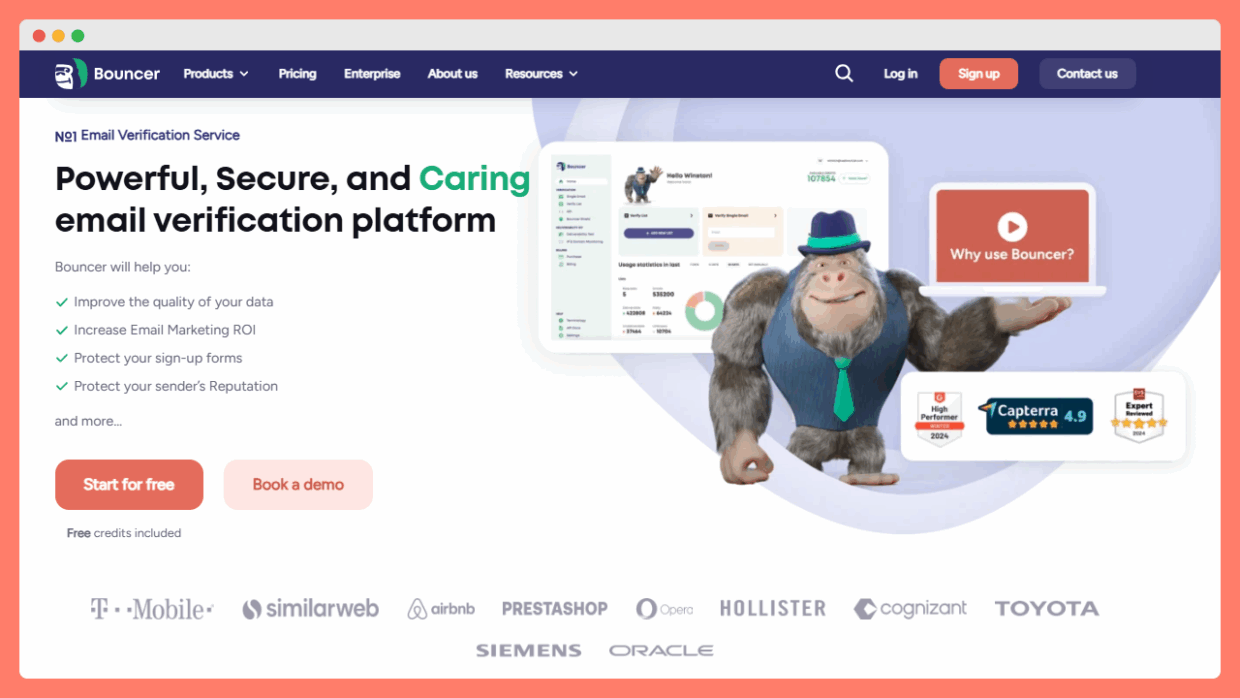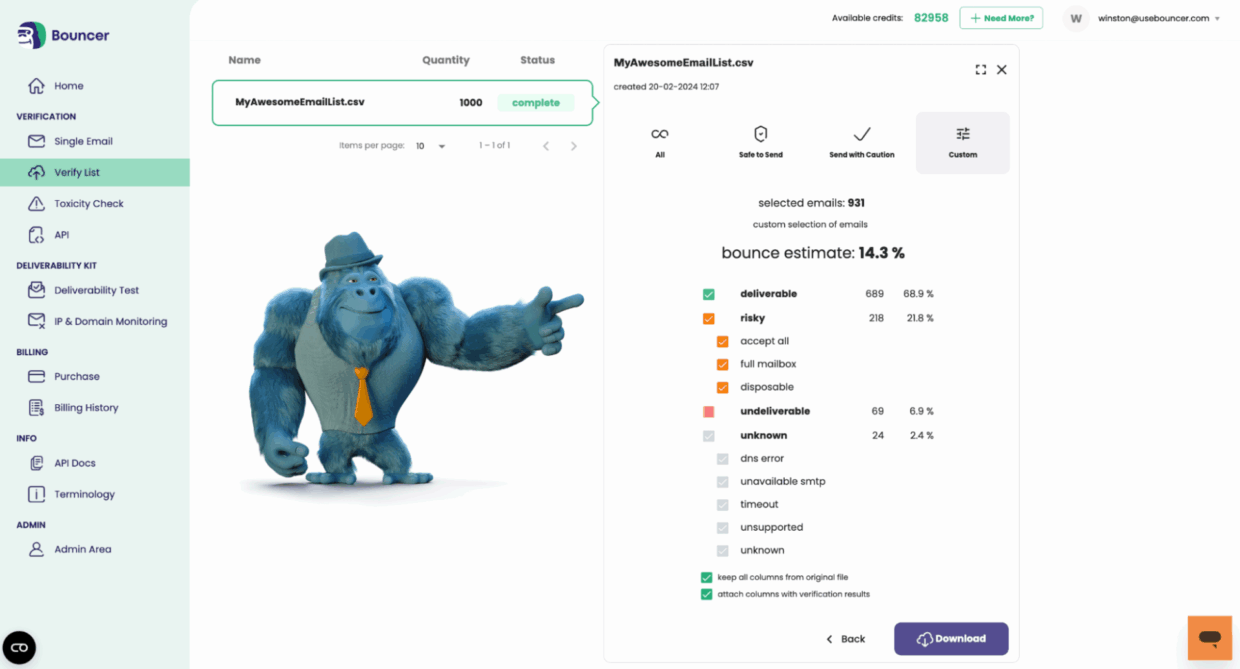So, you ask yourself: Is there a way to check if an e-mail address is valid without e-mailing it?
Short answer: Yes.
And if you care about sender reputation, ROI, and not paying to email bots or fake addresses, you’ll want to do this the smart way. That’s where email verification tools—like Bouncer—come in.
But let’s break it down for real-world marketers, salespeople, founders, or even the occasional “I-found-this-email-on-LinkedIn” enthusiast. Here’s what you actually need to know.
Why you should never blindly trust that email list
Let’s be honest: the world is full of people who sign up with addresses like bob+test123@invalid-domain.com or notarealemail@domainthatdoesntexist.net. Maybe you built a list from website opt-ins. Maybe you scraped a few addresses (we won’t tell).
Or maybe you inherited a spreadsheet that looks like it’s been around since Hotmail was cutting-edge.
Either way, invalid email addresses can turn your best intentions into a deliverability disaster.
Here’s why:
- Sender reputation tanks: Too many email bounces? Major email service providers will start flagging your domain and IP. Pretty soon, your valid emails will land in spam.
- Wasted budget: You pay for every email sent, even to the wrong or fake accounts. That’s just lighting money on fire.
- Spam traps and risky addresses: Hit too many, and your marketing campaigns get blacklisted.
- Embarrassment: Sending an email blast to hundreds of unverified emails and watching 30% bounce isn’t just a bad look. It’s a marketing horror story.
So, before you hit “send,” you need a way to check if an email address exists and is valid—without firing off an awkward test message to the intended recipient.
What makes an email address “valid” anyway?
Let’s get a few terms straight, since “valid” can mean a lot of things in email land.

- Syntax validation: Does the email address follow formatting rules? No missing “@,” no forbidden characters, etc. This is step one, and even a basic free email checker or Google Sheets formula can do this.
- Domain verification: Does the domain name exist? Does it have valid DNS records and an active mail server (MX record)? If a domain doesn’t exist or can’t accept emails, you’re wasting your time.
- Mailbox verification: Is there an actual email account behind the address? This is the trickiest part, and it’s where most cheap email validation tools give up.
So, the full process to verify an email address (without sending an email message) goes far beyond just looking for an “@” and a dot.
Old-school ways to check if an email address is valid
People love to get creative (or desperate). If you google search “is there a way to check if an e-mail address is valid without e-mailing it,” you’ll find lots of hacky advice:
- DNS lookup: You can manually run a DNS query on the domain to check if it has valid MX records. Sure, you’ll find out if the domain has a mail exchanger set up, but you won’t know if the mailbox exists.
- Command line telnet: Techies might try connecting to the recipient’s email server using telnet and running a manual SMTP handshake. Theoretically, you can see if the address is accepted, but most modern email servers won’t reveal if the address is valid—too many spammers have abused this trick.
- Search engine stalking: People will sometimes search for the address on Google or social media. Maybe you’ll find a profile or public mention, but it’s hardly a reliable verification method.
- Mail server guessing: Try emailing “postmaster@domain.com” and hope for an error message. This is a great way to get your own address flagged as a spammer. Please don’t.
None of these methods are reliable, scalable, or safe for a mailing list with more than ten entries. Plus, manually checking every address is like using a magnifying glass to check a haystack for needles—just with less payoff.
Email verification tools = the smarter way to validate email addresses
Now, let’s talk about the smarter way to find out is there a way to check if an e-mail address is valid without e-mailing it. Let’s talk about email verification tools.
A reliable email verification tool doesn’t just check if an email address follows basic formatting rules. It runs a sequence of advanced checks, combining:
- Syntax validation: Catches typos, formatting errors, and invalid syntax.
- Domain and MX record checks: Confirms that the domain exists and can receive incoming emails.
- Mailbox-level verification: Quietly “pings” the mail server to see if the specific mailbox exists—without triggering a delivery or tipping off the intended recipient.
- DNS records and IP address lookup: Helps spot fake addresses, spam traps, or risky addresses.
- Catch-all detection and spam trap checks: Determines if a domain accepts all mail (which can hide risky emails) or is on blacklists.
- Free email checker support: Flags addresses from free providers like Gmail or Yahoo, which might be more prone to abuse in bulk lists.
The best tools wrap all of this in a user friendly dashboard, handle bulk verification for massive mailing lists, and can integrate with Google Sheets, your email marketing platform, or your CRM via API integration.
Why Bouncer is the right solution (and not just because we say so)
Now, you want a solution that’s fast, accurate, and easy to use. For all those who prefer smarter ways to find out is there a way to check if an e-mail address is valid without e-mailing it, we have a tip: Check Bouncer.

Not just any email verification tool, but a genuinely reliable email verification tool built to do the dirty work—without risking your sender reputation or annoying your intended recipients.
What sets Bouncer apart?
1. Advanced, real-time email validation
Bouncer doesn’t just validate email addresses with basic syntax validation. It runs a full spectrum of checks: from domain verification and MX record checks to mailbox-level verification, DNS lookup, and more.
If an email address exists, Bouncer will know—without sending an email message.
2. Bulk verification for massive lists
Uploading a CSV, pasting a column from Google Sheets, or integrating with your CRM? Bouncer makes bulk verification easy, handling thousands (or millions) of email addresses at once. No more invalid entries or unverified emails sneaking through.
3. World-class deliverability insights
Good sender reputation starts with a clean list. Bouncer gives you a detailed report of valid email addresses, risky emails, spam traps, and invalid addresses.
Every result is clear and actionable—helping you clean up your list and improve successful email delivery rates, not just check a box.

4. Seamless API integration and user friendly dashboard
Tech teams love Bouncer’s API integration, which makes it easy to plug email verification directly into signup flows, product onboarding, or marketing campaigns. Prefer to work from a dashboard? Bouncer’s interface is as simple as a search bar, with intuitive filters and instant feedback. Free credits for testing mean you can try before you buy.
5. Designed to protect your sender reputation
One bad mailing list can wreck months of hard work. Bouncer’s verification process is built to minimize email bounces, avoid spam complaints, and protect your IP address and domain name system reputation. If you care about your emails landing in inboxes—not spam folders—you need this kind of insurance.

The full Bouncer verification process: How it works
Let’s walk through what happens when you run an email (or a mailing list) through Bouncer:
Step 1: Syntax validation
Each address is screened for basic formatting rules. No more “john.smith@@gmail…com” making it through the cracks.
Step 2: Domain verification
Is the domain name real? Does it have valid MX records? Is the mail server live, and does it accept incoming emails?
Step 3: Mailbox verification
Here’s the magic. Bouncer attempts a non-intrusive handshake with the email server, using advanced protocols to check if the email account actually exists—without sending any email message to the intended recipient.
Step 4: Risk analysis
Bouncer checks for known spam traps, disposable addresses, free email providers, and risky emails that could hurt your sender reputation.
Step 5: Results & reporting
You get a report that sorts emails into valid email addresses, risky addresses, invalid addresses, and even “unknown” entries (for those rare cases where the server doesn’t cooperate).
Download, review, and import directly to your favorite email service providers.
No guesswork, no accidental spamming, and no more crossing your fingers hoping an address is valid without actually knowing.
How Bouncer helps your email marketing
Email marketing isn’t about sending messages to as many people as possible. It’s about reaching real humans who might care.
If you’re still running email campaigns with unverified emails, you’re doing it the hard (and expensive) way.
With Bouncer’s email verification tool, you can:
- Lower your bounce rate overnight—your emails land, not boomerang.
- Protect your sender reputation—critical for long-term success with any email provider.
- Avoid spam traps and complaints—no blacklists, no “marked as spam” headaches.
- Save on costs—why pay for invalid addresses or fake emails?
- Boost your ROI—more real emails, more real conversions.
- Integrate with the tools you already use—Google Sheets, CRMs, marketing platforms, you name it.
Think of Bouncer as the bouncer at the VIP club door—only letting in the real deal, no imposters or party crashers.
Free tools vs. reliable verification
You might be tempted to use a free email checker or run a bulk validation script you found on a search engine.
And sure, for checking a handful of addresses, those can work—sort of.
But most free tools stop at syntax validation or domain checks.
They’ll tell you if the formatting is right and if the domain exists, but they won’t catch the mailbox-level fakes or risky addresses hiding on your list.
If you want to actually check if an email address is valid without emailing it, you need a tool that can:
- Do real-time MX record checks
- Run DNS lookups
- Verify the mailbox exists without sending a message
- Detect catch-alls and spam traps
- Integrate with your workflow (from Google Sheets to CRM to email marketing software)
In short, you need Bouncer, or a tool built for pros, not amateurs.

Common myths + why you should ignore them
“If it’s in the right format, it’s fine.”
Nope. Formatting rules only catch typos. There are millions of valid-looking addresses that go nowhere.
“Just email it and see if it bounces.”
Sure, if you like risking your sender reputation and watching your bounce rate soar. You don’t want to be the person who learns about spam complaints the hard way.
“All providers are the same.”
Not even close. Some tools rely on old databases or unreliable methods. Bouncer uses real-time checks, live server verifications, and the latest domain name system data.
The real-world payoff: Cleaner lists, better campaigns, less stress
Running email campaigns in 2025 is a minefield if you’re not using a reliable email verification tool. The difference between successful email delivery and a marketing flop comes down to one thing: valid email addresses.
Here’s what you get when you make Bouncer your go-to:
- Fewer email bounces: Less wasted budget, fewer angry bosses, more results.
- Cleaner mailing lists: No more unverified emails or invalid entries messing up your data.
- Boosted engagement: Reach more real people. Every message counts.
- Good sender reputation: Stay in the good graces of Gmail, Outlook, and every major provider.
- Peace of mind: Know your address is valid before you send.
Stop guessing, start verifying
So, is there a way to check if an e-mail address is valid without e-mailing it? Yes! Don’t leave it to chance, hope, or a search bar. The answer is a professional-grade email verification tool like Bouncer.
You get better results, protect your sender reputation, and save yourself from the pain of sending into the void (or the spam folder). Don’t let fake addresses, invalid syntax, or risky emails sabotage your next campaign.
Make Bouncer your list’s new best friend – and check if given address is valid address, beyond syntax errors.
Ready to stop guessing and start verifying? Clean your next list with Bouncer and watch your email deliverability—and ROI—finally live up to your ambitions.

Want to check if an email is valid right now? Try Bouncer’s free email checker and get some free credits to see the results yourself. Your future inbox (and your marketing team) will thank you.
FAQ: Is there a way to check if an e-mail address is valid without e-mailing it & more
Can I verify email addresses in bulk?
Absolutely. Bouncer was built for bulk verification. Upload your list, clean it in minutes, and export a squeaky-clean mailing list.
Does Bouncer work with Google Sheets?
Yes, you can integrate Bouncer with Google Sheets to clean lists on the fly, or plug it into your own internal workflows.
Will recipients know I’m checking their address?
Nope. The mailbox verification process is stealthy—no awkward “test” emails land in the inbox.
How accurate is Bouncer?
Let’s just say: it’s the email verifier trusted by service providers, SaaS brands, and high-volume senders around the world. It’s one of the tools with the most accurate results in the field.
Does Bouncer spot risky addresses and spam traps?
You bet. Avoid spam traps, catch-alls, and role-based emails before they can hurt your campaigns.

